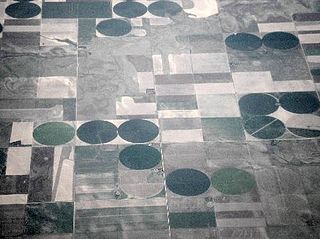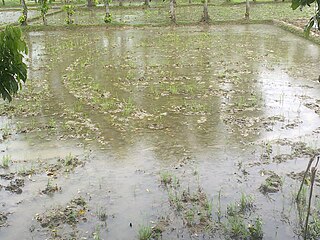The following outline is provided as an overview of and topical guide to agriculture:

A farmer is a person engaged in agriculture, raising living organisms for food or raw materials. The term usually applies to people who do some combination of raising field crops, orchards, vineyards, poultry, or other livestock. A farmer might own the farmland or might work as a laborer on land owned by others. In most developed economies, a "farmer" is usually a farm owner (landowner), while employees of the farm are known as farm workers. However, in other older definitions a farmer was a person who promotes or improves the growth of plants, land, or crops or raises animals by labor and attention.

A farm is an area of land that is devoted primarily to agricultural processes with the primary objective of producing food and other crops; it is the basic facility in food production. The name is used for specialized units such as arable farms, vegetable farms, fruit farms, dairy, pig and poultry farms, and land used for the production of natural fiber, biofuel, and other commodities. It includes ranches, feedlots, orchards, plantations and estates, smallholdings, and hobby farms, and includes the farmhouse and agricultural buildings as well as the land. In modern times, the term has been extended so as to include such industrial operations as wind farms and fish farms, both of which can operate on land or at sea.

A market garden is the relatively small-scale production of fruits, vegetables and flowers as cash crops, frequently sold directly to consumers and restaurants. The diversity of crops grown on a small area of land, typically from under 0.40 hectares to some hectares, or sometimes in greenhouses, distinguishes it from other types of farming. A market garden is sometimes called a truck farm in the USA.
Agribusiness is the industry, enterprises, and the field of study of value chains in agriculture and in the bio-economy, in which case it is also called bio-business or bio-enterprise. The primary goal of agribusiness is to maximize profit while satisfying the needs of consumers for products related to natural resources such as biotechnology, farms, food, forestry, fisheries, fuel, and fiber.
Farmers Weekly is a magazine aimed at the British farming industry. It provides news; business features; a weekly digest of facts and figures about British, European and world agriculture; and livestock, arable and machinery sections with reports on technical developments, farm sales and analysis of prices. It has both charted and captured agricultural changes. It has been vocal in its advocacy for the farming sector.
Farm World is a weekly United States farming technology magazine that has been published 51 weeks a year, every Wednesday, since 1955 and is owned by MidCountry Media, Inc., who bought it from Daily Mail and General Trust in 2009. The magazine has its headquarters both in Indiana and Illinois.

Kwale County is a county in the former Coast Province of Kenya. Its capital is Kwale, although Ukunda is the largest town.

Tajikistan is a highly agrarian country, with its rural population at more than 70% and agriculture accounting for 60% of employment and around 20% of GDP in 2020. As is typical of economies dependent on agriculture, Tajikistan has a low income per capita: Soviet Tajikistan was the poorest republic with a staggering 45% of its population in the lowest income “septile”. In 2006 Tajikistan still had the lowest income per capita among the Commonwealth of Independent States (CIS) countries: $1,410 compared with nearly $12,000 for Russia. The low income and the high agrarian profile justify and drive the efforts for agricultural reform since 1991 in the hope of improving the population's well-being.

Jimmy Doherty is an English television presenter and farmer. A childhood friend of Jamie Oliver, Doherty is known for the show Jimmy's Farm, detailing the operation of the Essex Pig Company that he and his wife Michaela Furney own in Suffolk.

Agricultural land is typically land devoted to agriculture, the systematic and controlled use of other forms of life—particularly the rearing of livestock and production of crops—to produce food for humans. It is generally synonymous with both farmland or cropland, as well as pasture or rangeland.

Agriculture in the United Kingdom uses 69% of the country's land area, employs 1% of its workforce and contributes 0.5% of its gross value added. The UK currently produces about 60% of its domestic food consumption.

Agriculture in England is today intensive, highly mechanised, and efficient by European standards, producing about 60% of food needs with only 2% of the labour force. It contributes around 2% of GDP. Around two thirds of production is devoted to livestock, one third to arable crops. Agriculture is heavily subsidised by the European Union's Common Agricultural Policy.

Agriculture in Myanmar is the main industry in the country, accounting for 60 percent of the GDP and employing some 65 percent of the labour force. Burma was once Asia's largest exporter of rice, and rice remains the country's most crucial agricultural commodity.

Like the rest of the economy, agriculture in Estonia has been in great flux since the degeneration of the collective and state farm systems.
For centuries Iceland's main industries were fishing, fish processing and agriculture. In the 19th century, 70–80% of Icelanders lived by farming, but there has been a steady decline over the years and now that figure is less than 5% of the total population. It is expected that the number will continue to fall in the future. Only 1% of the total land area is under arable cultivation, confined almost exclusively to the peripheral lowland areas of the country.

Suffolk Rural College is an English further education college in the village of Otley, Suffolk.

Agriculture and horticulture in Flanders has traditionally a familial character, but just like agriculture in other regions, is increasingly characterised by an increase in scale, modernisation and expansion. In Flanders, intensive sectors constitute the largest segment of agriculture: pig breeding, poultry and dairy farming, vegetables and fruit, ornamental plant culture. In Wallonia, the French-speaking part of Belgium, the emphasis is more on arable farming and extensive soil-based cattle breeding.

Agriculture in Wales has in the past been a major part of the economy of Wales, a largely rural country that forms part of the United Kingdom. Wales is mountainous and has a mild, wet climate. This results in only a small proportion of the land area being suitable for arable cropping, but grass for the grazing of livestock is present in abundance. As a proportion of the national economy, the importance of agriculture has become much reduced; a high proportion of the population now live in the towns and cities in the south of the country and tourism has become an important form of income in the countryside and on the coast. Arable cropping is limited to the flatter parts and elsewhere dairying and livestock farming predominate.

Agriculture in Ireland began during the neolithic era, when inhabitants of the isle began to practice animal husbandry and farming grains. Principal crops grown during the neolithic era included barley and wheat.















